Formation of Point Defects Due to Aging under Natural Conditions of Doped GaAs
Abstract
:1. Introduction
2. Materials and Methods
3. Results and Discussions
4. Conclusions
Author Contributions
Funding
Institutional Review Board Statement
Informed Consent Statement
Data Availability Statement
Conflicts of Interest
References
- Quesnel, E.; Poncet, S.; Altazin, S.; Lin, Y.P.; D’Amico, M. Lifetime prediction of encapsulated CdSexS1-x quantum platelets for color conversion in high luminance LED microdisplays. Opt. Express 2023, 31, 10955–10964. [Google Scholar]
- Shimamura, K.; Takehara, T.; Ikeda, N. Measurement Results of Real Circuit Delay Degradation under Realistic Workload. IPSJ Trans. Syst. Lsi Des. Methodol. 2023, 16, 27–34. [Google Scholar]
- Yang, B.; Mei, S.; Zhu, Y.; Yang, D.; He, H.; Hu, R.; Li, Y.; Zou, J.; Guo, R. Precipitation promotion of highly emissive and stable CsPbX3 (Cl, Br, I) perovskite quantum dots in borosilicate glass with alkaline earth modification. Ceram. Int. 2023, 49, 6720–6728. [Google Scholar]
- Kim, H.-M.; KIM, D.-G.; Kim, Y.-S.; Kim, M.; Park, J.-S. Atomic layer deposition for nanoscale oxide semiconductor thin film transistors: Review and outlook. Int. J. Extrem. Manuf. 2023, 5, 012006. [Google Scholar]
- Tang, C.; Zhan, S.; Li, O.; Wu, Y.; Jia, X.; Li, C.; Liu, K.; Qu, S.; Wang, Z.; Wang, Z. Systematic investigation on stability influence factors for organic solar cells. Nano Energy 2022, 98, 107299. [Google Scholar]
- Wang, H.; Wang, Z.; Tang, X.; Liu, L.; Zhang, H.; Yao, X.; Wang, F.; Wu, S.; Liu, X. Understanding the doping effect in CsPbI2Br solar cells: Crystallization kinetics, defect passivation and energy level alignment. Chem. Eng. J. 2023, 453, 139952. [Google Scholar]
- Ghizzo, L.; Tremouilles, D.; Richardeau, F.; Vinnac, S.; Moreau, L.; Mauran, N. Preconditioning of p-GaN power HEMT for reproducible Vth measurements. Microelectron. Reliab. 2023, 144, 114955. [Google Scholar]
- Wei, Y.; Cheng, Z.; Jun, L. An overview on enhancing the stability of lead halide perovskite quantum dots and their applications in phosphor-converted LEDs. Chemical Society Reviews 2019, 48, 310. [Google Scholar]
- Krotkus, A. Semiconductors for terahertz photonics applications. J. Phys. D Appl. Phys. 2010, 43, 273001. [Google Scholar]
- Aithal, S.; Nazem, E.; Hassen, W.M.; Frost, E.; Duwowski, H. GaAs/AlGaAs heterostructure based photonic biosensor for rapid detection of Escherichia coliinphosphate buffered saline solution. Sens. Actuators B Chem. 2015, 207 A, 556. [Google Scholar]
- Neuhold, I.; Noga, P.; Sojak, S.; Petriska, M.; Degmova, M.; Slugen, J.; Krsiak, V. Application of Proton Irradiation in the Study of Accelerated Radiation Ageing in a GAAs semiconductor. Materials 2023, 16, 1089. [Google Scholar]
- Rajput, N.S.; Kotbi, A.; Kaja, K.; Jouiad, M. Long-term aging of CVD grown 2D-MoS2 nanosheets in ambient environment. Mater. Degrad. 2022, 6, 75. [Google Scholar]
- Yoon, S.; Seo, M.; Kim, I.S.; Kwangyeol, L.; Woo, K. Ultra-Stable and Highly Efficient White Light Emitting Diodes through CsPbBr3 Perovskite nanocrystals Silica Composite Phosphor Functionalized with Surface Phenyl Molecules. Small 2023, 19, 2206311. [Google Scholar]
- Yang, X.; Sang, Q.; Zhang, J.; Wang, C.; Yu, M.; Zhao, Y. A high-efficiency aging test with new data processing method for semiconductor device. Microelectron. Reliab. 2023, 143, 114940. [Google Scholar] [CrossRef]
- Torres, G. Crecimiento y Caracterización de Películas Epitaxiales de GaAs y AlGaAS Crecidas por Epitaxia en Fase Líquida; Centro de Investigación y Estudios Avanzados del IPN: México DF, Mexico, 1995. [Google Scholar]
- Bourgoin, J.C.; Von Bardeleben, H.J.; Stiévenard, D. Native defects in gallium arsenide. J. Appl. Phys. 1988, 64, R65–R92. [Google Scholar]
- Fonthal, G. Estudio de la Impurificación de Capas Epitaxiales de GaAs y AlGaAs en el Rango de Leve Hasta Fuerte Dopaje por Medio de Fotoluminiscencia y Fotorreflectancia; Universidad del Valle: Cali, CA, USA, 2001. [Google Scholar]
- Pavezzi, L.; Guzzi, M. Photoluminescence of AlxGa1-xAs alloys. J. Appl. Phys. 1994, 75, 4779. [Google Scholar]
- Sermage, B.; Long, S.; Deveaud, B.; Katzer, D. Lifetime of excitons in GaAs quantum well. J. Phys. Proc. 1993, C5, 19–25. [Google Scholar]
- Vashitsha, N.; Kumar, M.; Singh, R.K.; Panda, D.; Tyagi, L.; Chakrabarti, S. A Comprehensive study of ultrafast carrier dynamics of LT-GaAs: Above and below bandgap regions. Phys. B Condens. Matter 2021, 602, 412441. [Google Scholar]
- Oh, E.; Lee, T.K.; Park, J.H.; Choi, J.H.; Park, Y.J.; Shin, K.H.; Kim, K.Y. Carrier lifetime and spin relaxation time study for electrical spin injection into GaAs. J. Appl. Phys. 2009, 106, 043515. [Google Scholar] [CrossRef]
- Elsayed, M.; Krause-Rehberg, R. As-vacancy complex in Zn-diffused GaAs: Positron lifetime spectroscopy study. Scr. Mater. 2017, 131, 72–75. [Google Scholar]
- Niemeyer, M.; Kleinschmidt, P.; Walker, A.W.; Mundt, L.E.; Timm, C.; Lang, R.; Hannappel, T.; Lackner, D. Measurement of the non-radiative minority recombination lifetime and the effective radiative recombination coefficient in GaAs. AIP Adv. 2019, 9, 45034. [Google Scholar] [CrossRef]
- De Lyon, T.J.; Woodall, J.M.; Goorsky, M.S.; Kirchner, P.D. Lattice contraction due to carbon doping of GaAs grown by metalorganic molecular beam epitaxy. Appl. Phys. Lett. 1990, 56, 1040–1042. [Google Scholar] [CrossRef]
- Pietsch, U.; Holy, V.; Baumbach, T. Lattice Parameters and Strains in Epitaxial Layers and Multilayers. In High-Resolution X-ray Scattering, Advanced Texts in Physics; Springer: New York, NY, USA, 2004; Volume 79, pp. 1971–1977. [Google Scholar]
- Qadri, S.B.; Yousuf, M.; Kendziora, C.A.; Nachumi, B.; Fischer, R.; Grun, J.; Rao, M.V.; Tucker, J.; Siddiqui, S.; Ridway, M.C. Structural modifications of silicon-implanted GaAs induced by the athermal annealing technique. Appl. Phys. A 2004, 79, 1971–1977. [Google Scholar] [CrossRef]
- Bhunia, S.; Uchida, K.; Nozaki, S.; Sugiyama, N.; Furiya, M.; Morisaki, H. Metal organic vapor phase epitaxial growth of heavily carbon-doped GaAs using a dopant source of CCl3Br and quantitative analysis of the compensation mechanism in the epilayers. J. Appl. Phys. 2003, 93, 1613–1619. [Google Scholar] [CrossRef]
- Lanyi, S.; Pincik, E.; Nadazdy, V.; Wolcyrz, M. Lattice strain and defect structure of GaAs/native oxide interfaces. Prog. Surf. Sci. 1990, 35, 201–204. [Google Scholar] [CrossRef]
- Williams, E.W.; Bebb, B. Photoluminescence II: Gallium Arsenide. Semicond. Semimetals 1972, 8, 321–392. [Google Scholar]
- Ky, N.H.; Reinhart, F. Amphoteric native defect reactions in Si-doped GaAs. J. Appl. Phys. 1998, 83, 718. [Google Scholar] [CrossRef]
- Birey, H.; Sites, J. Radiative transitions induced in gallium arsenide by modest heat treatment. J. Appl. Phys. 1980, 51, 619. [Google Scholar] [CrossRef]
- Lum, W.Y.; Wieder, H.H. Photoluminescence of thermally treated n-type Si-doped GaAs. J. Appl. Phys. 1978, 49, 6187. [Google Scholar] [CrossRef]
- Bunea, M.M.; Dunham, S.T. Monte Carlo study of vacancy mediated impurity diffusion in silicon. Phys. Rev. B Cover. Condens. Matter Mater. Phys. 2000, 61, 2397. [Google Scholar] [CrossRef]
- Xu, H.; Lindefeltt, U. Electronic structure of neutral and charged vacancies in GaAs. Phys. Rev. B Cover. Condens. Matter Mater. Phys. 1990, 41, 5976–5990. [Google Scholar] [CrossRef] [PubMed]
- Ablekim, J.T.; Swain, S.K.; Yin, W.-J.; Zaunbrecher, K.; Burst, J.; Barnes, T.M.; Kuciauskas, D.; Wei, S.-H.; Lynn, K.G. Self-compensation in arsenic doping of CdTe. Nat. Sci. Rep. 2017, 7, 4563. [Google Scholar] [CrossRef] [PubMed]
- Parfitt, D.; Kordatos, A.; Filippatos, P.P.; Chroneos, A. Diffusion in energy materials: Governing dynamics from atomistic modelling. Appl. Phys. Rev. 2017, 4, 031305. [Google Scholar] [CrossRef]
- Naddaf, M. Formation of superhydrophobic porous GaAs layer: Effect of substrate doping type. Bull. Mater. Sci. 2022, 45, 89. [Google Scholar] [CrossRef]
- Pulzara-Mora, C.A.; Doria-Andrade, J.; Pulzara-Mora, A.; Bernal-Correa, R.; Rosales-Rivera, A.; López-López, M. Caracterización de capas de GaAs y GaAsMn depositadas por magnetrón sputtering. Superf. Vacío 2016, 29, 98–104. [Google Scholar]
- Sekine, T.; Uchinokura, K.; Matsuura, E. Two-phonon Raman scattering in GaAs. J. Phys. Chem. Solids 1977, 38, 1091–1096. [Google Scholar] [CrossRef]
- Jiang, D.-S.; Li, X.-P.; Sun, B.-Q.; Han, H.-x. A Raman scattering study of GaAs: As films lifted off GaAs substrate. J. Phys. D Appl. Phys. 1999, 32, 629–631. [Google Scholar] [CrossRef]
- Spirkoska, D.; Abstreiter, G.; Fontcuberta i Morral, A. Size and environment dependence of surface phonon modes of gallium arsenide nanowires as measured by Raman spectroscopy. Nanotechnology 2008, 19, 435704. [Google Scholar] [CrossRef]
- Kumaria, R.; Sahaib, A.; Goswani, N. Effect of nitrogen doping on structural and optical properties of ZnO nanoparticles. Prog. Nat. Sci. Mater. Int. 2015, 25, 300–309. [Google Scholar] [CrossRef]
- Espinoza, V.E. Estudo por Espectroscopia Raman de Efeitos de Localização das Excitações Elementares em Superredes e em Ligas Dopadas; Universidade Federal de São Carlos: São Carlos, Brazil, 2005. [Google Scholar]


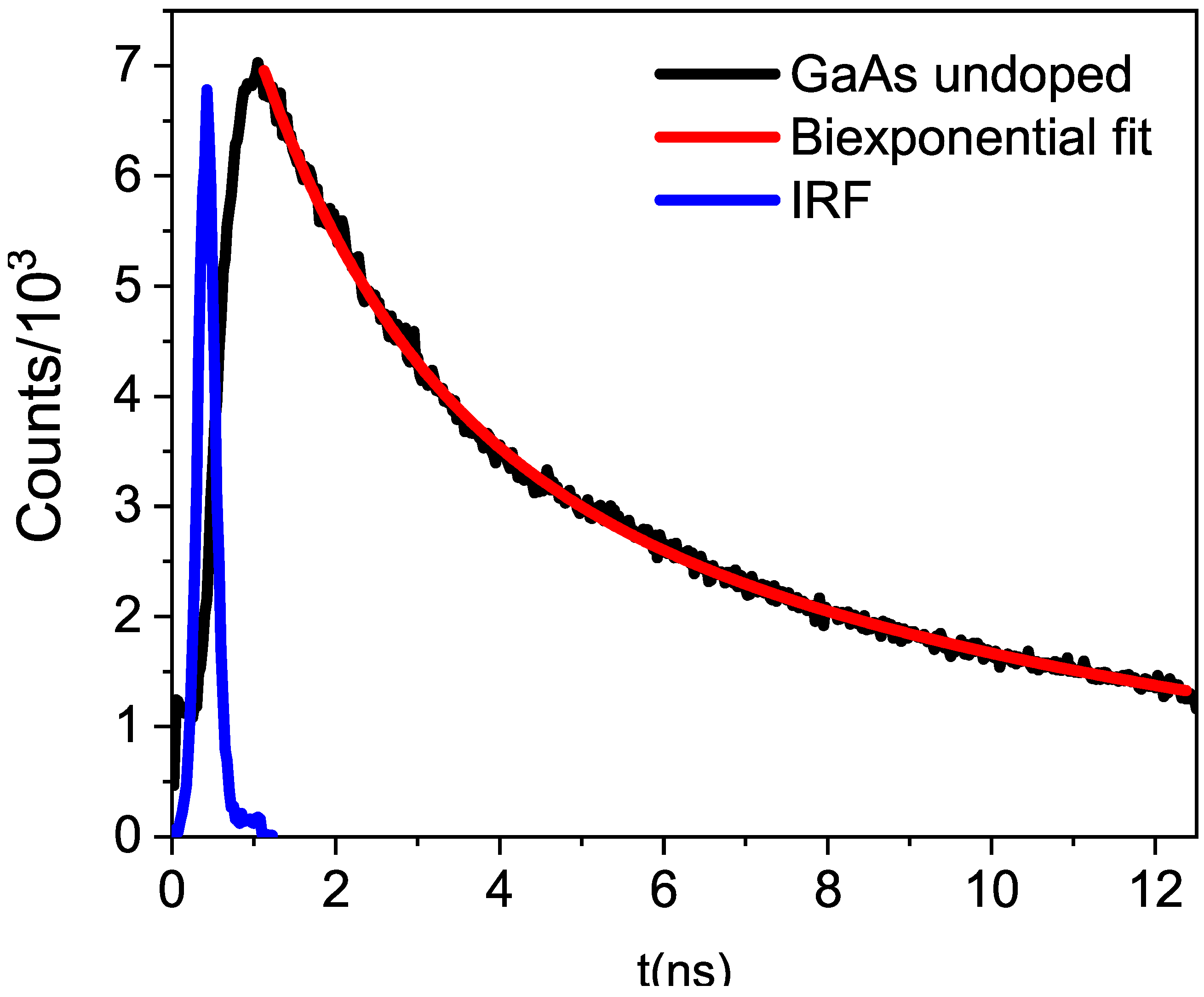
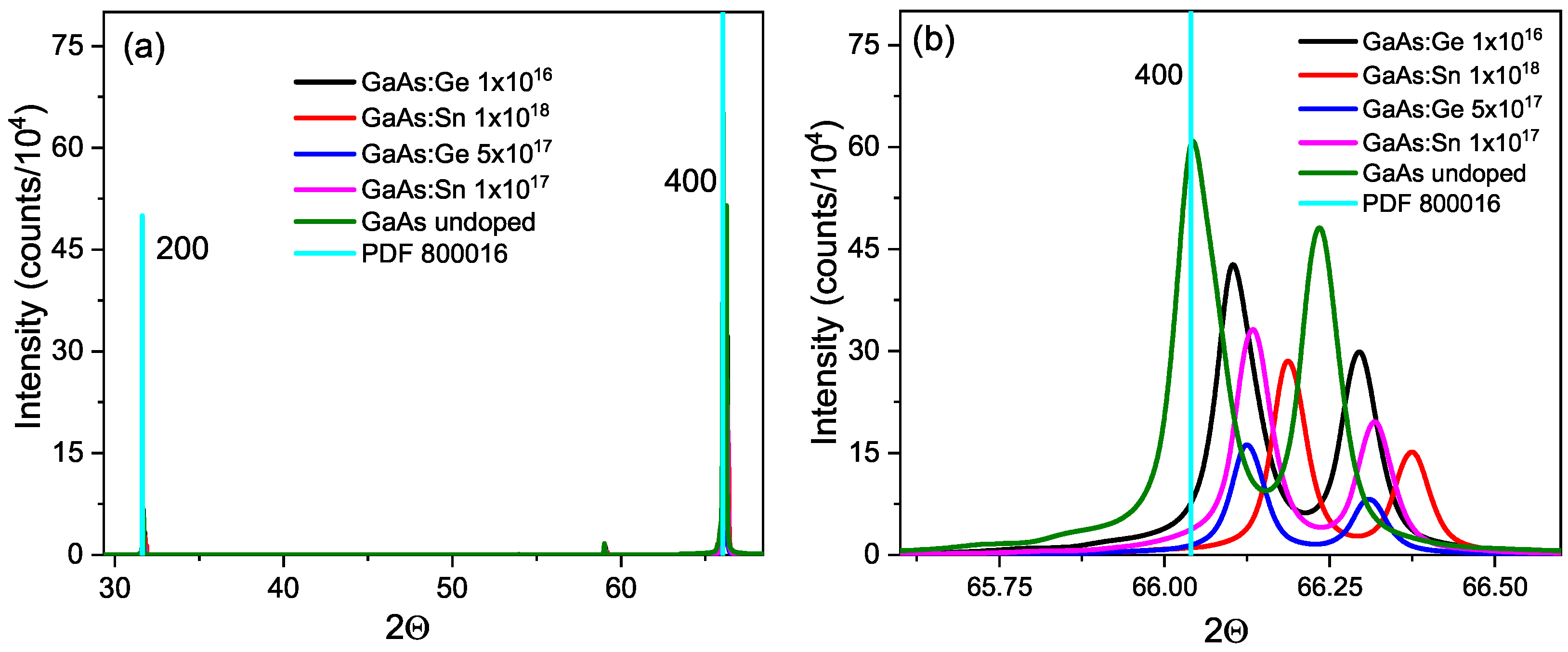
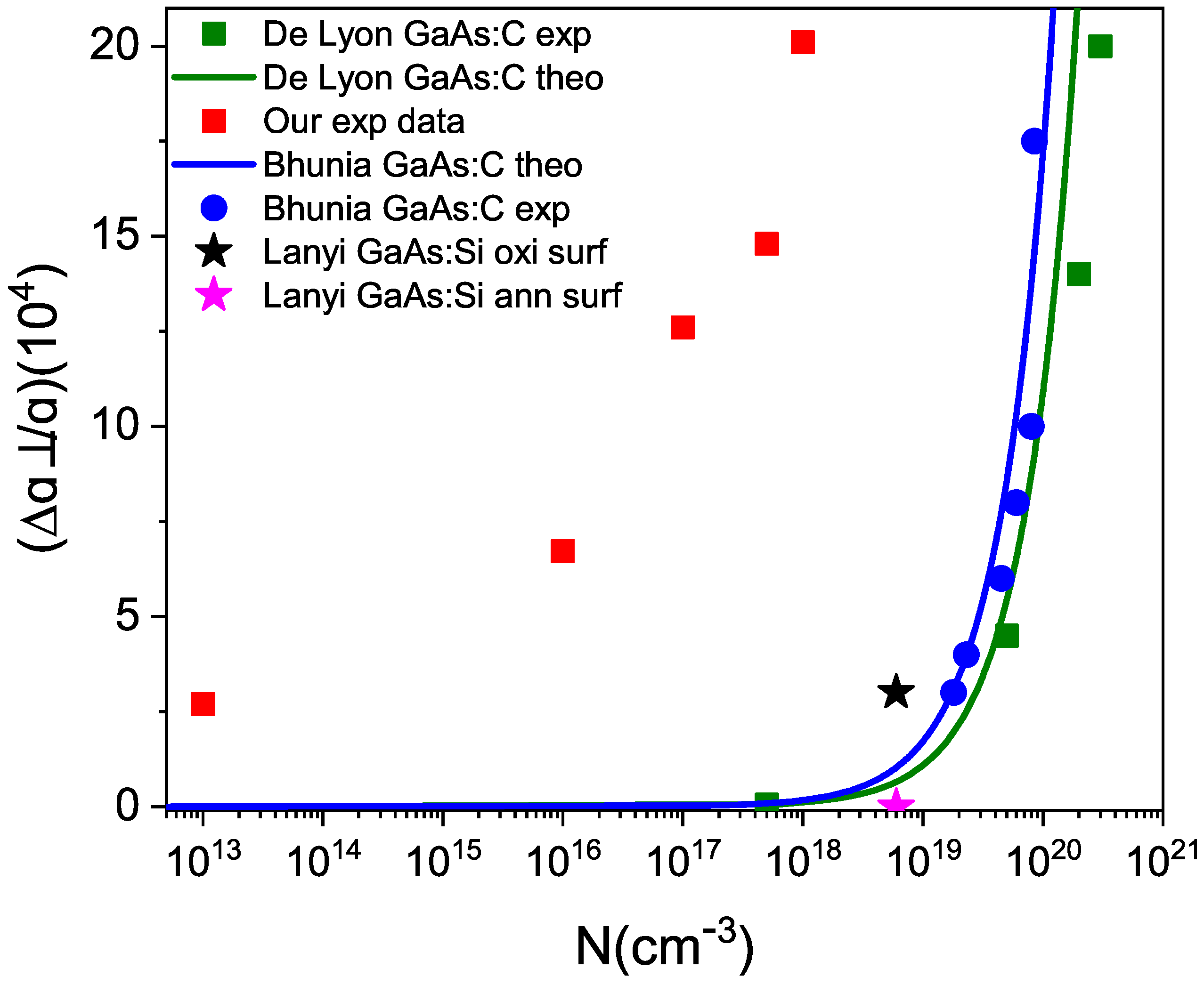
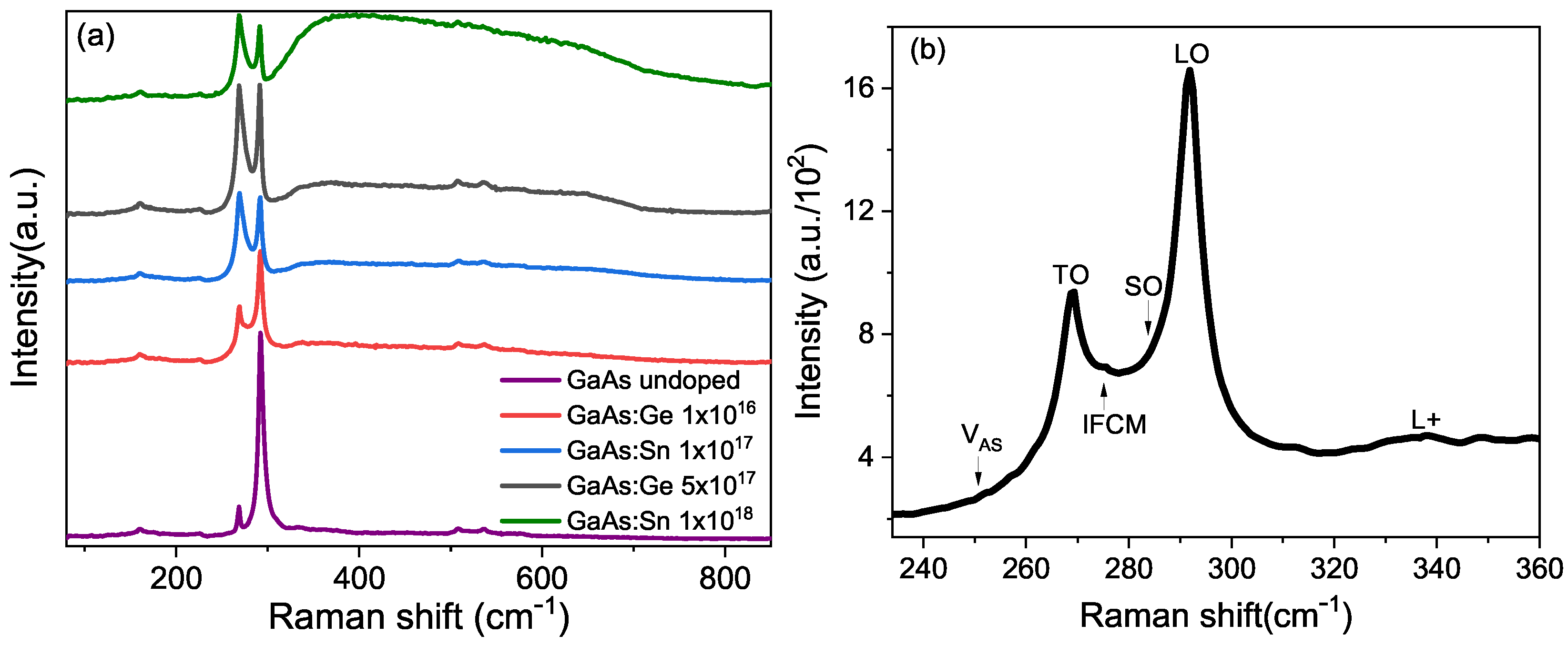
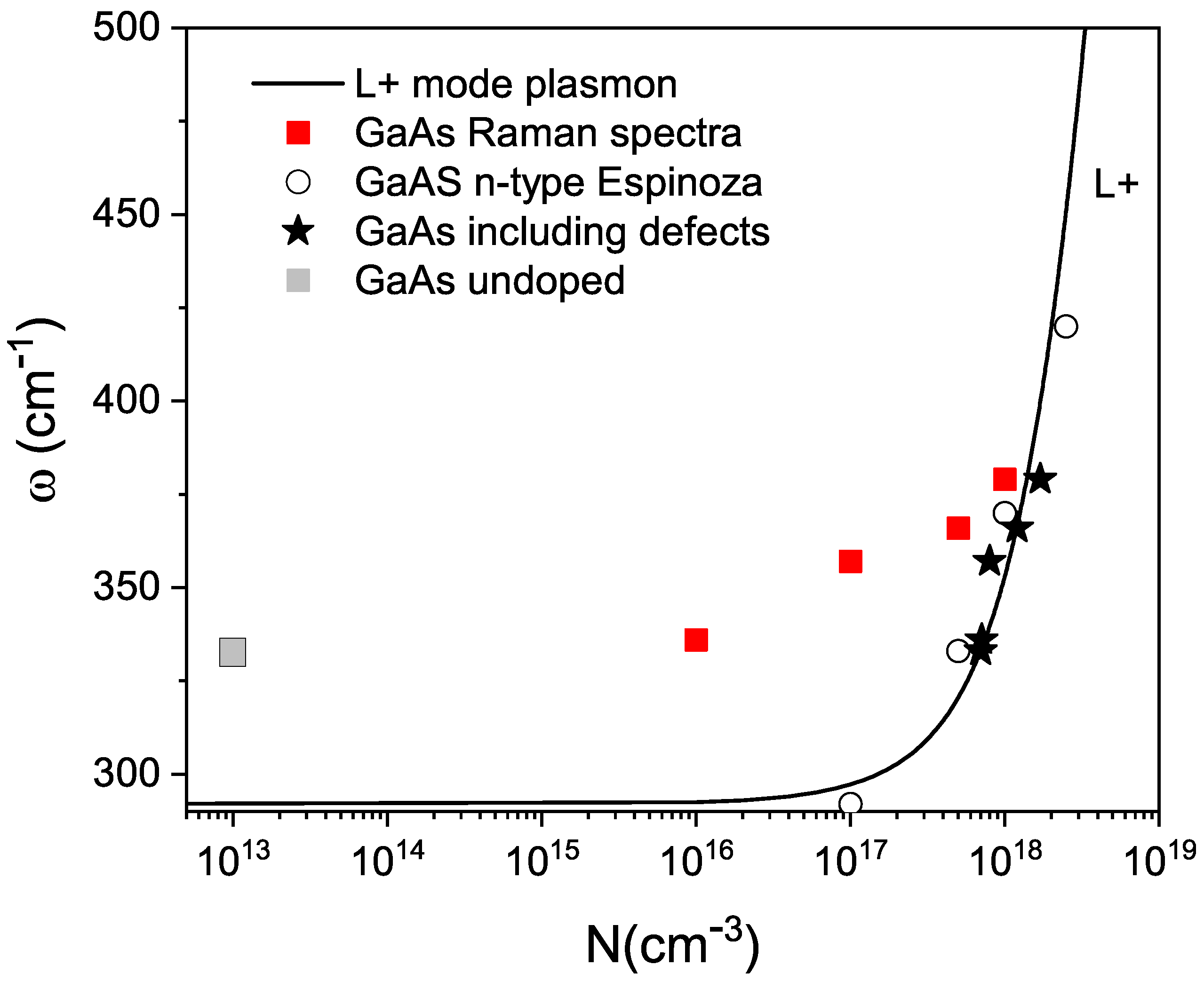
| SAMPLE | t1 | A1% | t2 | A2% |
|---|---|---|---|---|
| GaAs undoped | 0.80 (±0.10) | 14 | 7.18 (±0.33) | 86 |
| GaAs:Ge | 1.74 (±0.16) | 39 | 8.26 (±1.50) | 61 |
| GaAs:Sn | 1.71 (±0.13) | 41 | 8.60 (±1.50) | 59 |
| GaAs:Ge | 1.67 (±0.10) | 44 | 9.56 (±1.89) | 56 |
| GaAs:Sn | 1.47 (±0.04) | 45 | 9.76 (±2.11) | 55 |
| GaAs:Ge | 1.86 (±0.14) | 61 | 9.10 (±2.16) | 39 |
| SAMPLE | a (Å) | D (m) | |
|---|---|---|---|
| GaAs undoped | 5.6528 | 0.27 | 0.130 |
| GaAs:Ge | 5.6498 | 0.67 | 0.141 |
| GaAs:Sn | 5.6478 | 1.26 | 0.134 |
| GaAs:Ge | 5.6472 | 1.48 | 0.188 |
| GaAs:Sn | 5.6431 | 2.01 | 0.182 |
| Vacancies with Its State of Charge | Trap Energy in eV |
|---|---|
| 0.100 | |
| 0.068 | |
| 0.051 | |
| 0.145 | |
| 0.088 | |
| 0.042 |
Disclaimer/Publisher’s Note: The statements, opinions and data contained in all publications are solely those of the individual author(s) and contributor(s) and not of MDPI and/or the editor(s). MDPI and/or the editor(s) disclaim responsibility for any injury to people or property resulting from any ideas, methods, instructions or products referred to in the content. |
© 2024 by the authors. Licensee MDPI, Basel, Switzerland. This article is an open access article distributed under the terms and conditions of the Creative Commons Attribution (CC BY) license (https://creativecommons.org/licenses/by/4.0/).
Share and Cite
Zambrano-Rojas, S.; Fonthal, G.; Escorcia-Salas, G.E.; Sierra-Ortega, J. Formation of Point Defects Due to Aging under Natural Conditions of Doped GaAs. Materials 2024, 17, 1399. https://doi.org/10.3390/ma17061399
Zambrano-Rojas S, Fonthal G, Escorcia-Salas GE, Sierra-Ortega J. Formation of Point Defects Due to Aging under Natural Conditions of Doped GaAs. Materials. 2024; 17(6):1399. https://doi.org/10.3390/ma17061399
Chicago/Turabian StyleZambrano-Rojas, Samuel, Gerardo Fonthal, Gene Elizabeth Escorcia-Salas, and José Sierra-Ortega. 2024. "Formation of Point Defects Due to Aging under Natural Conditions of Doped GaAs" Materials 17, no. 6: 1399. https://doi.org/10.3390/ma17061399





